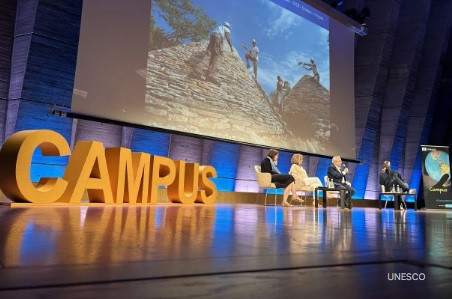
GCED Basic Search Form
Quick Search
현재 위치
뉴스

20 September 2023
"Living heritage connects communities, generations, and people", according to Tim Curtis, Head of the Living Heritage Entity and Secretary of the 2003 Convention for the Safeguarding of the Intangible Cultural Heritage (ICH), at an exceptional Campus at UNESCO House. Together with Lily Martinet, ICH Project Manager at the French Ministry of Culture, and Véronique Van de Voorde, ICH Expert, Director of the Musée de Folklore de Mouscron and Project Manager for the Direction des patrimoines culturels de la Fédération Wallonie-Bruxelles, some 750 young people from the Ile-de-France region gathered to discuss the subject, ahead of the European Heritage Days.
After recalling that "heritage connects people, enables them to develop a sense of community and brings societies to life", Tim Curtis and Véronique Van de Voorde emphasized the role of young people in the preservation of ICH: "It is essential, because heritage is only alive if it can be passed on to future generations (...) And on the other hand, heritage must adapt to the evolutions of young people, so that they find an interest in it".
The event was then punctuated by questions from the youngsters to the experts. Lily Martinet was able to answer Maya's question about intangible heritage as a tool to protect against excessive globalization: " Absolutely because we're talking here about very slow transmissions over generations. So we're talking about a completely different kind of time.
Does heritage help to ensure world peace?
, Gabriel
"Yes, one of the best examples may be the inscription of the Ssireum, the traditional Korean wrestling, for which the ambassadors of the two Koreas had to meet and exchange." Tim Curtis
Regarding the accessibility of heritage, Tim Curtis was able to explain to Nordi that there are "different levels of access, for example the baguette is something very easy, whereas certain skills require rarer techniques". Then, to Maëly's question as to whether the protection of ICH can be linked to the preservation of biodiversity: "Yes, for example, indigenous peoples have enormous knowledge of their environment, which has been passed down for generations".
What are the limits or threats to heritage?
, Eric
"For example, if there's a problem with standards, a project that goes against sustainable development, mutual respect between communities or involves animal cruelty will be rejected." Véronique Van de Voorde
"A project can also be refused if it is done solely with an economic perspective and could in the future lead to harmful mass tourism, for example." Lily Martinet
To conclude, several young participants were able to question the experts on the evolution of intangible heritage. According to Tim Curtis, the dynamic is very positive: "a few years ago, there was very little talk of it, but the Convention helped to bring it to light in 2003". Véronique Van de Voorde is similarly encouraged: "Inscribing an element on the heritage list ensures that it will be safeguarded in the future.
This fascinating exchange continued on September 16 and 17, 2023, during the European Heritage Days at UNESCO headquarters.
UNESCO would like to thank the ENGIE Foundation, partner of the UNESCO Campuses since 2014, and Sylvère-Henry Cissé, contributor and moderator of the event.
https://www.unesco.org/en/articles/intangible-heritage-treasure-protect-future-generations
